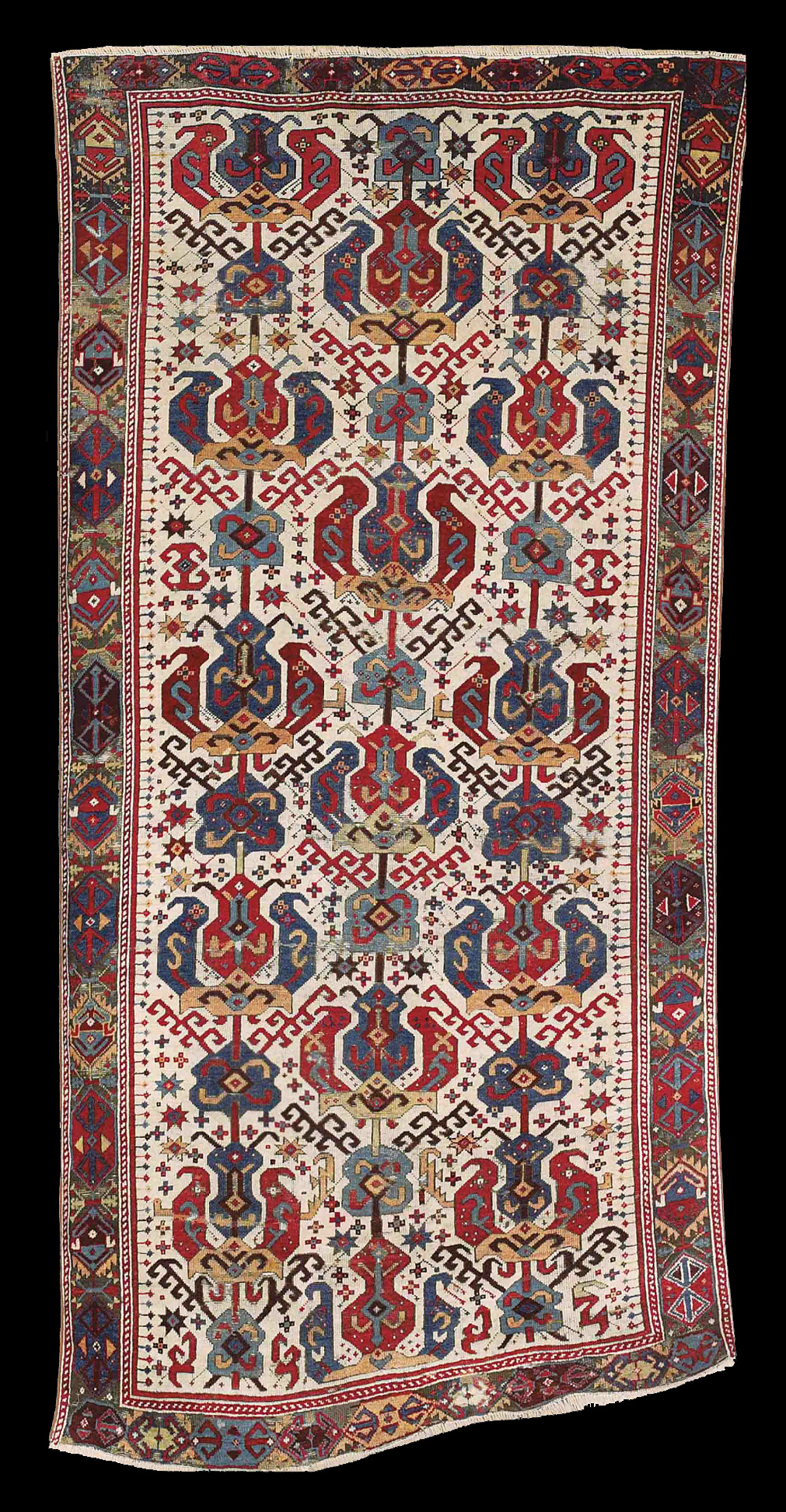AN EAST ANATOLIAN RUG
SECOND HALF 18TH CENTURY
Overall light wear with localised areas of wear, partly corroded colours, a
few small areas of repiling and repairs, one short tear
8ft.6in. x 4ft.4in. (259cm. x 132cm.)
Price Realized £58,850 ($90,864)
Sale Information
Christie's SALE 7988 —
ORIENTAL RUGS AND CARPETS
4 October 2011
London, King Street
Literature
Ulrich Schurmann, Caucasian Rugs, Braunschweig, n.d., pl.6
Robert Pinner and Michael Franses, 'Caucasian Shield Carpets', Hali, vol.1,
no.1, pl.70, p.17.
Lot Notes
There are two rugs which have been published which have very closely related
designs. One, which shares with the present rug an ivory field but with
slightly more angular drawing and a clear lozenge lattice formed of serrated
leaves, is in the Orient Stars Collection (E Heinrich Kirchheim et al,
Orient Stars, A Carpet Collection, Stuttgart and London, 1993, no.74,
p.140). The other, which shares the serrated leaf lattice with the Orient
Stars rug, but on a red ground, is published in various places including
Schurmann (op.cit., pl.94, p.257).
The design of all three is very clearly the same, or at least based on the
same original. In their important Hali article noted above Michael Franses
and Robert Pinner argue convincingly that they are closely related to the
Caucasian shield carpets. Whether the design derives from the shield design,
or whether they share a common root is less clear. Pinner and Franses do not
comment on this issue, simply stating that the designs are related. The very
clear lozenge lattice and the very rounded form of the composite palmette
elements in our carpet are both closest to the shield carpets that Pinner
and Franses conclude are the earliest, dating from "no later than the 18th
century" (op.cit, p.21). It seems probable that both share a common source,
a carpet that unfortunately no longer survives.
The present rug has always been published as being Caucasian, although
Schurmann hedges his bets, having decided to include it in the Kazak section
in his book on Caucasian Carpets, by calling it an Armenian carpet;
"Armenian", that useful attribution for the Caucasian carpet that does not
quite fit into any neat category! Its wefting is in a natural dark brown
wool, much more typical of Eastern Anatolia than of the Caucasus. The wool
also has the softness and the handle the floppiness that are much more
typical of Anatolian than Caucasian weavings, particularly in the 18th
century. The brown ground border is almost identical to that on a carpet
published by Franz Bausback as being from the Konya district, with a field
of ascending palmettes on yellow ground (Anatolische Knüpfteppiche aus vier
Jahrhunderten, Mannheim 1978, pp.34-5). The two carpets also share the
variety of small motifs scattered within the field. A similar carpet is in
the Keir Collection (Friedrich Spuhler, Islamic Carpets and Textiles in the
Keir Collection, London, 1978, no.70, pp.134 and 136). Another rug, albeit
very damaged, that was closely related to the Bausback example was sold in
these Rooms 30 April 1998, lot 7, the note to which compared it to another
rug sold here from the Bernheimer Collection which had a very Caucasian
style medallion with pendants but on a red ground. The structures of all of
these carpets are very similar, and all are without a doubt from Anatolia.
The designs however in each case bear strong resemblances to those of the
Caucasus which, combined with the structure, strongly indicates an origin in
the East of the country. This is a relationship which would reward further
study.
Of all these Anatolian rugs the present example is the best preserved, with
a wonderfully strong design. It is a fascinating carpet from an academic
viewpoint, and an enormously attractive one from an aesthetic one. |

